Intel Alder Lake-H Core i9-12900HK Review: MSI's Raider GE76 Goes Hybrid
by Brett Howse on January 25, 2022 9:00 AM EST- Posted in
- CPUs
- Intel
- MSI
- Laptops
- Alder Lake
- GE76 Raider
- 12th Gen Core
- Alder Lake-H
Battery Life
Built on what Intel now calls Intel 7, the new Alder Lake processors do not get a completely new foundry node to reduce power consumption. The idea of having P-Cores and E-Cores though is an interesting one for the laptop space, as in theory the E-Cores could lower power consumption quite a bit. However, that discussion will need to likely wait for the thin and light notebooks to arrive with U-Series and P-Series processors as a H-Series device with a massive RTX 3080L Ti GPU, DDR5-4800, multiple PCIe 4.0 SSDs, and a 360 Hz display are not going to be a showcase for power efficiency of a processor.
As always, our battery life tests have the display set to 200 nits brightness and the system set in its most efficient mode.
Web Battery
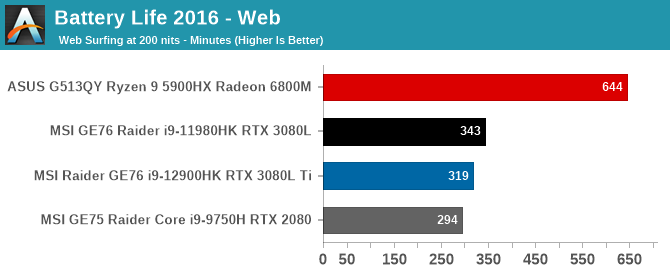
Our first test shows that the Raider GE76, despite a 99.9 Wh battery, performs very poorly if used as a portable computer. Thankfully it is not really intended to be used this way, as it is big and heavy to carry around, but the regression over the outgoing Tiger Lake model is clear. What is also very clear is how much better AMD is able to power-gate its large discrete GPU compared to NVIDIA, as the AMD gaming system dominates in the battery life tests.
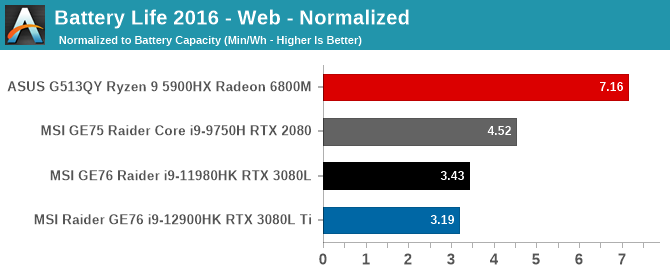
The normalized results remove the battery size from the equation and drops the new Raider GE76 to the bottom of the results. There are several variables, so it is difficult to pinpoint exactly what is causing the power consumption regression, but likely DDR5-4800 is a part of it.
PCMark Modern Office Battery
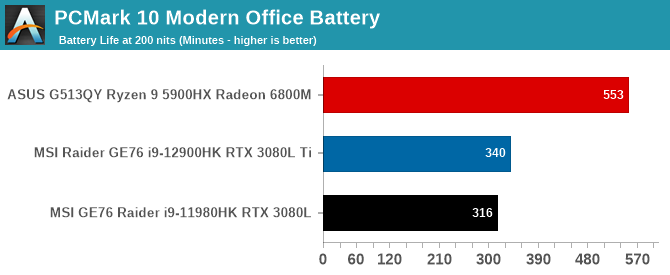
The PCMark test will run a series of workloads in a ten-minute window, and if a device finishes the work quicker, it is able to idle for a larger percentage of the ten minutes, which probably assists the new Alder Lake system here as it is overall a more performant device compared to the outgoing Tiger Lake laptop.
Movie Playback
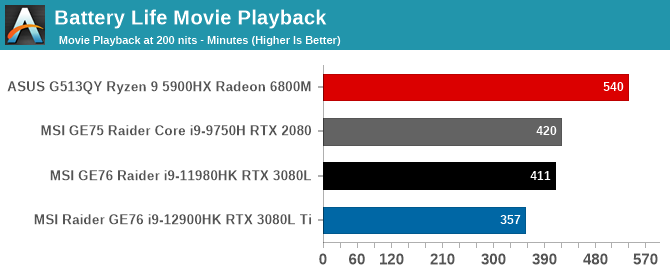
The battery life regression is even more pronounced in the battery life playback time. Clearly there is a significant amount of passive power draw in this system.
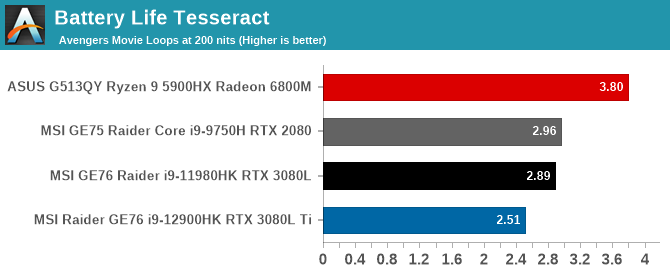
Looking at the Tesseract score, which divide the movie playback time by the length of the movie The Avengers shows that you would run out of juice halfway through your third viewing.
Battery Life Summary
In a word the battery life could be summed up as "unimpressive". The Raider GE76 is not an ideal test bed to determine CPU efficiency under load since the underlying power draw is significant. To see how Alder Lake compares we will have to wait for more power efficient platforms to get more meaningful results.
Storage Performance
Unlike with the desktop counterpart for Alder Lake, the laptop variants are limited to “just” PCIe 4.0 storage. The Raider GE76 offers support for two of them, and the system shipped with two Samsung PM9A1 PCIe 4.0 drives at 1 TB each.


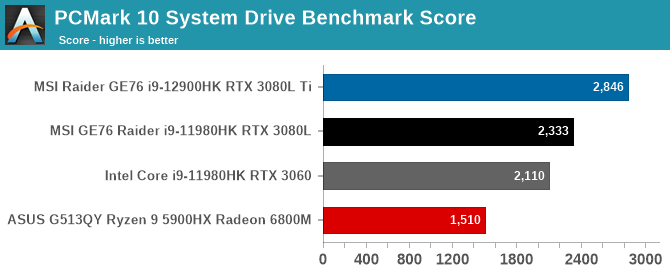
The drive performance is class leading, with the highest results we have ever achieved in the PCMark Full System Drive test.










153 Comments
View All Comments
lmcd - Wednesday, January 26, 2022 - link
Ryzen 6000 does not exist as of 1/26/2022.Your analogy is awful but ironically correct -- comparable European/Japanese sports cars also get horrifying mileage, and the performance gap is in the nonsense territory with fanboys on either side debating what the immeasurable differences mean.
Spunjji - Thursday, January 27, 2022 - link
👆PeachNCream - Friday, January 28, 2022 - link
Its always funny to watch people.try to compare computers to cars. That literally happens all of the time in the tech industry and rarely fits the situation because, well obviously, computers are not cars.TheinsanegamerN - Friday, January 28, 2022 - link
It's always funny to watch people complain about car comparisons simply because "well cars and computers are different" without any other context. Tells me you have no real counterargument.cowymtber - Tuesday, January 25, 2022 - link
Tim from HUB...Do your power normalization magic, and release the demons!Timoo - Tuesday, January 25, 2022 - link
I haven't really seen the comment floating around yet.SInce Intel got bumped by Apple, could this design be their result out of a failed collaboration?
I mean, they planned to bring this design, say, 3 to 5 years ago, for Apple MacBooks etc.
But Apple -meanwhile- was thinking they could do better by themselves?
So, now Intel had their Big.Little design, in co-op with Apple, and nowhere to go but to the x86 market in full-force. Not backed by the idea that they would also end up in the Apple store...
Brett Howse - Tuesday, January 25, 2022 - link
Not likely. Apple is a big customer, but not Intel's biggest.Timoo - Tuesday, January 25, 2022 - link
Ok, I just found it kind of "coincidential" that a year after we got the news Apple has dumped Intel for their own M1, Intel comes with a "similar" design. Which must have been in development already since -say- 2016 or 2017.Maybe I have to search it in the area of thinking along with the ARM train, where Big.Little is normal, and Intel realising they have Big.Little for x86 laying around (Atom + Core). I just got the impression that it was Apple who might have triggered this idea with Intel...
But then again; that would bring a lot of Queensize Drama to this release (the failed Intel-Apple chip). And I love drama. So I am biased, presumably :-D
Thanks for your reply!
IntelUser2000 - Wednesday, January 26, 2022 - link
No, the hybrid combo was first presented by Intel back in 2005 or so by then-CTO Justin Rattner.https://images.anandtech.com/reviews/tradeshows/ID...
It might have been first at Intel if they didn't have a braindead management and CEO and executed on 10nm.
lmcd - Wednesday, January 26, 2022 - link
Intel probably started work closer to 2012. The roadmap for Atom has been converging toward serving as a desktop/laptop small core since the smartphone Atoms got canned and tablet got deprioritized. By no coincidence, that happened when Apple slammed every smartphone chip with the A7, which was also Intel's public wakeup that Apple could easily reach laptop performance on a quick timeline.